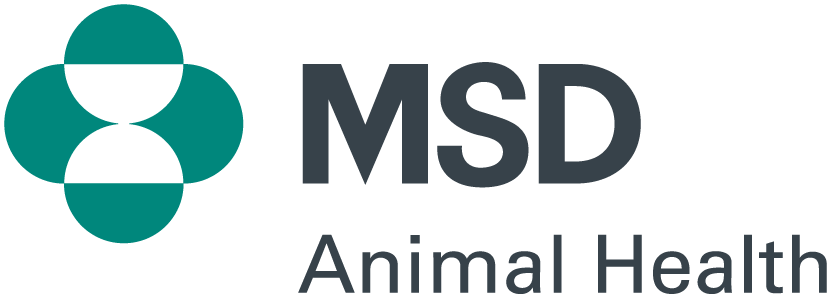

Herd Profitability
Why does cattle reproduction matter?
Reproduction strongly impacts profits, so planning and management are essential. Nutrition, genetics, housing and disease prevention must all align to optimize and secure livestock health.
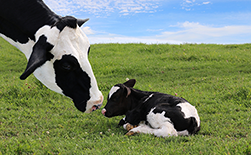
Dairy cattle breeding profits
Dairy cattle reproduction influences milk production,
which accounts for:
- More than 88% of the gross income of dairy farms (U.S. data).
- The number of replacement heifers available on farms, accounting for almost 23% of the cost of producing milk (U.S. data).
Economics of reproductive performance are strongly influenced by the lactation curve, which peaks 40–70 days after calving. The main objective is to maximize the time the cows remain within the most profitable part of the lactation curve in the cattle breeding cycle1.
The most important key performance indicators2 used as measurable values in dairy cow production are:
Days to first service
- Time from calving to the first time the animal breeds.
- Chosen mating start date, heat detection efficiency and the herd’s reproductive health affect this.
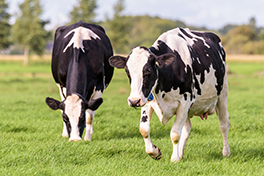
Age at first calving
- First calving marks the beginning of a heifer’s productive life.
- Delaying the first calving decreases overall dairy cow production.
- Farmers should strive to meet these targets to optimize profits.
Profit Gained by Decreasing the Average Age of Different Cow Breeds at First Calving

Conception rate
- Percentage of animals serviced that subsequently become pregnant.
Heat detection rate
- Has strongest influence on the pregnancy rate.
- Heat detection should commence four weeks prior to mating start date.
- Implementing heat detection before mating start date will enable you to anticipate the next heat event.
- All heats should be recorded.
Number of services per conception
- Varies depending on breeding system.
Days open
- Interval from calving to conception.
- Influenced by the voluntary waiting period, heat detection rate, conception rate and overall herd health and nutrition.
Calving interval
- Interval from the birth of one calf to birth of next.
- The target is to have one calf per cow every 365 days.
- According to the ICBF, average calving interval for dairy herds in 2019 was 390 days.
Pregnancy rate
- Most common estimate of fertility.
- Rate = number of impregnated cows ÷ number of cows that were eligible for pregnancy.
Dairy cows that become pregnant faster typically spend more time in the early part of lactation, resulting in higher milk production and sales potential. They also have a lower risk of being culled because of cattle pregnancy failure.
Optimum herd profitability is achieved by minimizing the proportion of the herd culled for involuntary or biological reasons and maximizing the proportion culled for voluntary or economic reasons.
Reasons for culling can be divided into:
- Involuntary culling because of disease, injury, infertility or natural death.
- Voluntary culling of healthy animals because of low milk yield or overstocking and where farmers can freely decide which cows to remove from the herd.
Economic Value of a Cow Pregnancy
- Difference in expected future net returns from two identical cows, one pregnant and the other open.
- To calculate: compare the retention pay-off (RPO) or future profitability of the two cows4.
- The RPO is the expected profit from keeping the cow compared with its immediate replacement.
- The future income potential of a cow is calculated and compared to that of her potential replacement, allowing cows to be ranked based on their future profitability, thus helping farmers to make good culling decisions.
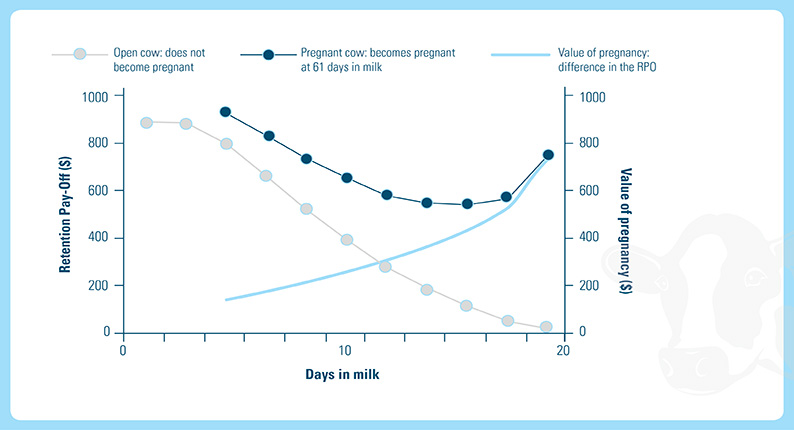
Reproductive performance economics are a function of two main opportunity costs:
- Forgone profit as cows remain open more than 120 days in milk (DIM), thus spending a high proportion of their lifetime in the later stages of lactation.
- Failure to fulfill the full profit potential in otherwise profitable cows that are replaced sooner-than-optimally due to failure in achieving pregnancy.
Direct costs:
- Extra semen, labor and veterinary and drug costs.
Opportunity costs
The opportunity costs of prolonged nonpregnancy or culling may be higher than the obvious direct costs. Recent studies show cost per day open ranging from $0.44 US at 130 DIM, to $1.37 at 160 DIM, and $1.71 at 190 DIM.
Cost per day open varies throughout lactation and depends on:
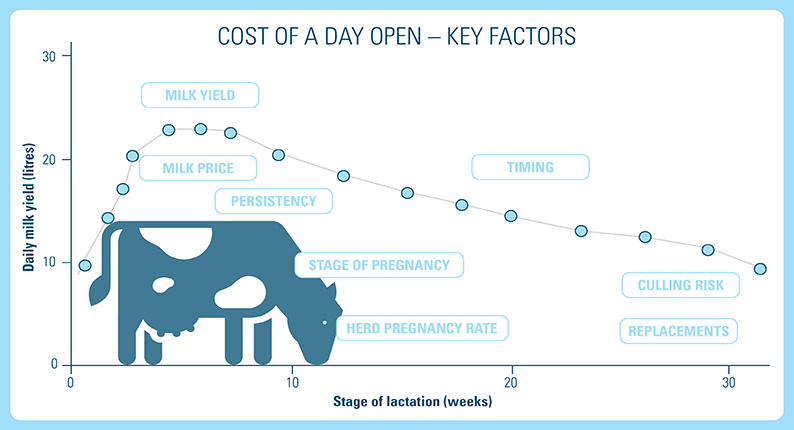
Milk yield
- Level of milk production.
- As milk yield increases, value of impregnating the cow again also increases.
Persistency
- Slope of the curve after peak milk production.
- If production decreases quickly after the peak, then persistency is low, increasing cost of nonpregnancy.
Timing: days in milk
- After peak milk production, cows must be re-impregnated before production and profits drop.
- In an open cow, the value of pregnancy decreases as the DIM increases, because the cow spends more time in the less profitable end of the lactation curve.
Herd pregnancy rate
- Percentage of cows that become pregnant within a given period of time from total eligible for impregnation.
- As herd pregnancy rate increases, value of pregnancy decreases, because the remaining cows are more likely to become pregnant soon.
Culling risk
- Losses depend on the age and the production level of the cow culled.
- Losses represent missed future income, the cost of replacement and lost genetic potential.
- As risk of culling pregnant cows increases, value of pregnancy decreases.
Replacements
- Availability, cost and expected milk yield of replacements impacts pregnancy value.
- Value of impregnating open cows increases in line with the cost of their replacement.
Milk price
- As the price of milk increases, the value of pregnancy increases, because the potential profit from selling milk is higher.
- Marginal milk is usually profitable, but increased cost of feed must be accounted for in net revenue.
State of pregnancy
- Refers to time of pregnancy in proximity to next lactation peak.
- Loss in value if abortion occurs.
When insemination rates (IRs) in a herd are low, implementing systematic fixed timed artificial insemination (F.T.A.I.) programs can help to increase the IR by reducing the variability in the time to the first insemination and to re-insemination. This means immediate increases in costs (e.g., in terms of drugs, labor and semen), but extra cost will likely be covered within 9 to 18 months.
Marginal milk
- Additional amount of milk produced from increasing feed intake over that required to cover the cow’s total maintenance cost.
- Most profitable milk produced on dairy farms.
More selective culling
- Increasing herd pregnancy rate allows removal of lower-productivity cows.

Dairy Cattle Breeding Calculators
Although difficult to predict, computer programs and spreadsheets can estimate profitability by integrating various factors.
Florida Dairy Computer Program
Allows users to evaluate the economic benefits of changes in dairy management and calculate the economic value of improvements in reproduction.
University of Wisconsin Extension–Dairy Management
These support tools help dairy professionals improve the herd economic performance and make management decisions by focusing on model-based scientific research.
Reproduction tools include:
- Economic Value of Sexed Semen Programs for Dairy Heifers.
- UW-DairyRepro.
- Economic Analysis of Switching from 2× to 3× Milking.
- Cow Value.
Cornell College of Agricultural and Life Sciences:
Provides dairy evaluation tools, cost calculators and articles that aid in assessing dairy herd profitability.
Download Reproduction Cost Calculator
Economics of Reproduction Spreadsheet:
Pregnancy cost tool from Dr. John Fetrow at the University of Minnesota.
Dairy Feed Efficiency Calculator:
Developed by Donna Amaral-Phillips (a dairy extension specialist) and Nick Roy (county extension agent for agriculture and natural resources).
- LeBlanch, Stephen. 2007. WCDS Advances in Dairy Technology 19: 201-214.
- Ettema JF, Santos JEP. 2004.Impact of Age at Calving on Lactation, Reproduction, Health, and Income in First-Parity Holsteins on Commercial Farms. Journal of DairyScience 87(8):2730-42.
- Beavers L, Van Doormal B. 2015. Age at First Calving and Profitability. Canadian DairyNetwork.
- De Vries, A, van Leeuwen J, Thatcher WW. 2004. Economic importance of improved reproductive performance. Proceedings 2004 Florida Dairy Reproduction Road Show

